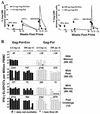Critical role for Env as well as Gag-Pol in control of a simian-human immunodeficiency virus 89.6P challenge by a DNA prime/recombinant modified vaccinia virus Ankara vaccine
- PMID: 12021347
- PMCID: PMC136190
- DOI: 10.1128/jvi.76.12.6138-6146.2002
Critical role for Env as well as Gag-Pol in control of a simian-human immunodeficiency virus 89.6P challenge by a DNA prime/recombinant modified vaccinia virus Ankara vaccine
Abstract
Cellular immune responses against epitopes in conserved Gag and Pol sequences of human immunodeficiency virus type 1 have become popular targets for candidate AIDS vaccines. Recently, we used a simian-human immunodeficiency virus model (SHIV 89.6P) with macaques to demonstrate the control of a pathogenic mucosal challenge by priming with Gag-Pol-Env-expressing DNA and boosting with Gag-Pol-Env-expressing recombinant modified vaccinia virus Ankara (rMVA). Here we tested Gag-Pol DNA priming and Gag-Pol rMVA boosting to evaluate the contribution of anti-Env immune responses to viral control. The Gag-Pol vaccine raised frequencies of Gag-specific T cells similar to those raised by the Gag-Pol-Env vaccine. Following challenge, these rapidly expanded to counter the challenge infection. Despite this, the control of the SHIV 89.6P challenge was delayed and inconsistent in the Gag-Pol-vaccinated group and all of the animals underwent severe and, in most cases, sustained loss of CD4(+) cells. Interestingly, most of the CD4(+) cells that were lost in the Gag-Pol-vaccinated group were uninfected cells. We suggest that the rapid appearance of binding antibody for Env in Gag-Pol-Env-vaccinated animals helped protect uninfected CD4(+) cells from Env-induced apoptosis. Our results highlight the importance of immune responses to Env, as well as to Gag-Pol, in the control of immunodeficiency virus challenges and the protection of CD4(+) cells.
Figures






References
-
- Allen, T. M., T. U. Vogel, D. H. Fuller, B. R. Mothe, S. Steffen, J. E. Boyson, T. Shipley, J. Fuller, T. Hanke, A. Sette, J. D. Altman, B. Moss, A. J. McMichael, and D. I. Watkins. 2000. Induction of AIDS virus-specific CTL activity in fresh, unstimulated peripheral blood lymphocytes from rhesus macaques vaccinated with a DNA prime/modified vaccinia virus Ankara boost regimen. J. Immunol. 164:4968-4978. - PubMed
-
- Amara, R. R., F. Villinger, J. D. Altman, S. L. Lydy, S. P. O'Neil, S. Staprans, D. C. Montefiori, Y. Xu, J. G. Herndon, L. S. Wyatt, M. A. Candido, N. L. Kozyr, P. L. Earl, J. M. Smith, H.-L. Ma, B. D. Grimm, M. L. Hulsey, J. Miller, H. M. McClure, J. M. McNicholl, B. Moss, and H. L. Robinson. 2001. Control of a mucosal challenge and prevention of AIDS by a multiprotein DNA/MVA vaccine. Science 292:69-74. - PubMed
-
- Barouch, D. H., S. Santra, M. J. Kuroda, J. E. Schmitz, R. Plishka, A. Buckler-White, A. E. Gaitan, R. Zin, J. H. Nam, L. S. Wyatt, M. A. Lifton, C. E. Nickerson, B. Moss, D. C. Montefiori, V. M. Hirsch, and N. L. Letvin. 2001. Reduction of simian-human immunodeficiency virus 89.6P viremia in rhesus monkeys by recombinant modified vaccinia virus Ankara vaccination. J. Virol. 75:5151-5158. - PMC - PubMed
-
- Barouch, D. H., S. Santra, J. E. Schmitz, M. J. Kuroda, T. M. Fu, W. Wagner, M. Bilska, A. Craiu, X. X. Zheng, G. R. Krivulka, K. Beaudry, M. A. Lifton, C. E. Nickerson, W. L. Trigona, K. Punt, D. C. Freed, L. Guan, S. Dubey, D. Casimiro, A. Simon, M. E. Davies, M. Chastain, T. B. Strom, R. S. Gelman, D. C. Montefiori, and M. G. Lewis. 2000. Control of viremia and prevention of clinical AIDS in rhesus monkeys by cytokine-augmented DNA vaccination. Science 290:486-492. - PubMed
Publication types
MeSH terms
Substances
Grants and funding
LinkOut - more resources
Full Text Sources
Other Literature Sources
Medical
Research Materials

